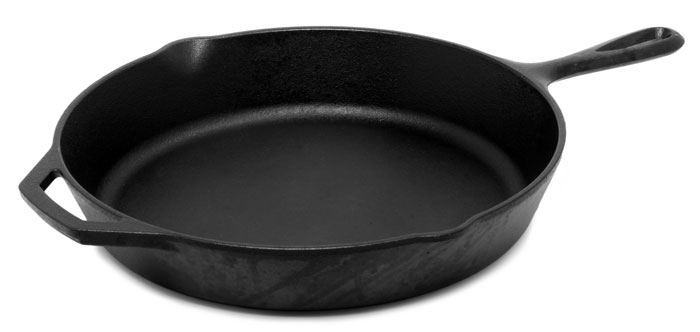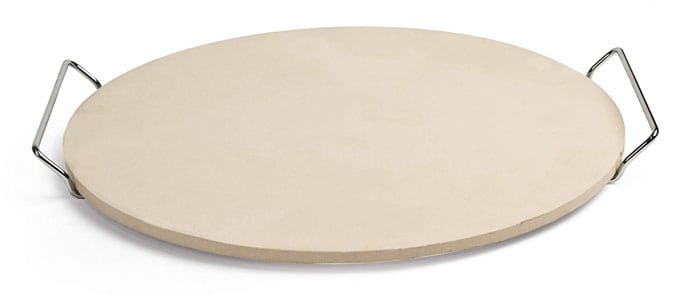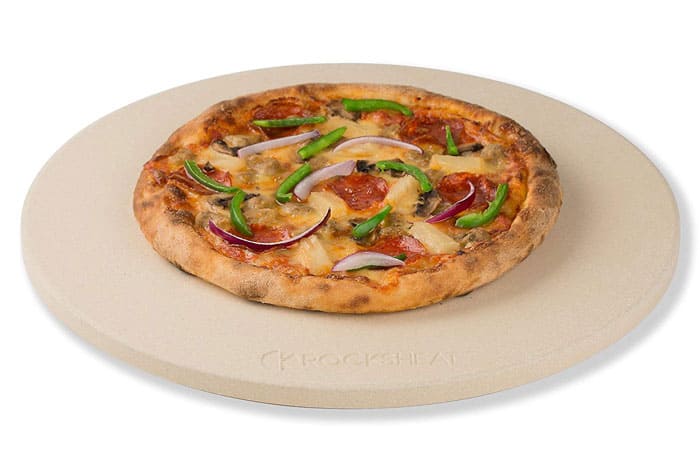Now, we all may not be acquainted with the term “pizza stone” and conversely, many may scratch their heads at the term “baking stone”. The reason they are often used interchangeably is that the function they serve is very similar.
A baking stone is a portable surface upon which you put the dough or batter to bake in the oven.
The pizza stone is a subset of baking stones. It is made particularly for baking a pizza. As such a pizza baking stone is usually circular in shape, however other designs exist.
It is devised to function like a tray on which you can place the dough to bake. Pizza stones are popular because they tend to absorb moisture and give the pizza a crispy texture.
But how do you clean it? Maintenance is very important to make sure your tools give you the performance you desire. And that’s what we’re gonna talk about.
Types Of Pizza Stones
First and foremost, you need to know about the various different types of pizza stones, based on the materials used. That’s because the type does matter when it comes to cleaning it. There are conveniences that come with each type. You should choose the method based on that. Here’s a short discussion on them.
1. Stone
It is a very classic material. With the baking stone, you can rest assured that it’ll last. Stone is naturally porous, so it absorbs moisture really well. That’s good news for your pizza, as it can get extra crunchy. The material also makes the pizza appear as if it was baked in a masonry oven, giving its appearance a classic look.
In regards to cleaning, there are pros and cons to using one made of stone. The pores that are naturally embedded in the material also collect food particles. This can make cleaning a little difficult as you can just wipe it clean. You’ll have to take a go at the nooks and crannies to effectively wash it.
However I don’t want to sell stone short, it does have its upsides. It is very minimally affected by water. This means you can give it a good wash. Water can be harmful to certain types of pizza stones and that can make cleaning a little complicated. With this, however, you can just rinse it.
2. Cast Iron
Iron is an interesting choice for a pizza stone. It is highly conductive and helps cooking faster. However, since it is metallic there are no natural pores. The pores are applied on the surface. And while this is not as effective, they do absorb moisture enough to give your pizza a good crunch.

The lack of pores might seem like its undoing, but it does make cleaning the thing a whole lot easier. Since the pores are applied on, they are much more regularly shaped and smaller. This makes the stone less likely to collect food bits. You can just wipe away the whole thing with a cloth.
Cast iron, though, has one weakness and that is water. Exposure to excess water and steam can cause it to develop rust spots. Rust hosts pathogens. It can be painted over but that only leads to paint peeling off. One solution to combat water is electroplating the thing with another more corrosion resistant metal.
3. Ceramic
Ceramic is a sort of a metaphoric mix between cast iron and stone pizza stones. It goes halfway. The only downside to ceramic is its higher cost. However, aside from that, it is an excellent choice of material for a pizza stone. It conducts heat well enough and absorbs moisture too.

The peculiar thing about ceramic is that although it has pores that are natural, they are too small to be of a nuisance when it comes to cleaning. They are simply too small for any food particles to stick in. So you can sweep it all in with just a cloth. The surface appears smooth as well.
Another big plus that ceramics tend to have is their resistance to chemicals. While chemical cleaning of utensils should be avoided anyway, this is still worth mentioning since baking soda is often used to clean pizza stones. Ceramic is immune to all that and more.
4. Cordierite
Cordierite is a very unique material. Physically it is similar to ceramic but it is a crystalline material that contains iron. And just like ceramic, they are quite expensive. However, the upside to them is their thermal stability. You don’t have to worry about overheating it. It is a more general purpose stone.

There aren’t any pores in cordierite, and while this is a disadvantage when it comes to baking, it makes cleaning easy. You don’t have to pick at the nooks and crannies and you can get the thing clean in minutes. You can even do a dry wipe and get it cleaned effectively.
This material is immune to any effects water has. So by all means, wash away. It is also chemically very stable and that makes it immune to chemicals. Again, I advise against using chemicals to clean your stone but use all the baking soda you want. It can be clean by almost any cleaning method.
Preparation
Before you get your hands dirty and begin cleaning there are some things you should bear in mind. Certain precautions will make cleaning easy and safe.
Safety
Always remember that safety comes first. Before we get started, you need to be aware of certain safety precautions that will ensure you aren’t hurt. It will also make sure that your pizza stone gets out of the cleaning process without getting damaged or ruined. The following steps should help you in cleaning effectively.
Do not use soap. Soap might seem like a good thing to use in cleaning utensils, and for other utensils, it is. But for a pizza stone, it is a bad idea. That’s because most pizza stones have pores. These pores are good for your pizza but they aren’t good for soap-cleaning.
The soap often ends up getting stuck in the pores when you scrub the soap in. No matter how much you rinse some will remain. This will result in your food gaining an unpleasant soapy smell every time you bake it using that pizza stone.
Make sure that the stone is cold before you start. This should be common sense. A hot pizza stone is a burn hazard, undoubtedly. However, it’s better you let the thing cool slowly on its own. If you keep fast-cooling it with water, over time it’ll develop deformities, especially if it’s an iron one.
Keep the stone on a safe surface so that it doesn’t fall over. A fall might snap the stone clean in half. This is usually the case with ceramic stone, or even one made of clay or stone. Iron pizza stones are largely immune to these types of damage though.
Mental preparation is key as well. If your pizza stone is iron or stone, be prepared to bear its weight. It should be also be known that you will have to be a little patient too, to ensure the best clean.
Step-By-Step Of Cleaning A Pizza Stone
There are actually multiple ways you can clean your pizza stone. It depends on the type of pizza stone, as well as your convenience. We’ll be describing the three main ways it is done.
Hand Wipe Method
This is the most basic method. It involves simple wiping and cleaning with your bare hands.
Tools And Ingredients
- A blunt tool; this is to scrape off the food parties. It can be anything as long as it isn’t sharp.
- Water; while I do discourage using excess water, you’ll need some to finish up.
- A cloth; this is to wipe the pizza stone with.
Procedure
Step 1: Make sure that the stone is clean. Don’t start if it’s too hot. You’ll get burnt.
Step 2: Start with the blunt tool. Safely scrape at the surface to the pizza stone. This will ensure that all the dirt will come off easily. However, you do need to take care when doing so, be careful to scrape not too hard as this might damage the stone.
Step 3: The tool can be a brush or a spatula. Whatever it is, make sure that it is not metallic. A metal tool can cause scratches on your stone. You should also be wary of sharp objects or objects with pointy edges as they can damage your stone too.
Step 4: If the scraping doesn’t work, don’t push it. You might end up damaging the pores. Instead, soak it in water. The water should loosen up the particles for an easy scrape. It does come at a risk, particularly for cast iron pizza stones as water can cause it to rust.
Step 5: Finally, you go for the wipe. After all the stubborn food bits are taken care of, you wipe away all that is left. Use a soft cotton cloth or towel. Apply just a little bit of water. Then, gently wipe away the rest of the grime and dirt for a clean pizza stone.
Step 6: Let the stone dry before you use it. A wet stone might crack.
Baking Soda Method
As the name suggests, you use baking soda to soften up the dirt for an easier clean.
Tools And Ingredients
- Baking soda; this will dissolve the food particles.
- Warm water; the water will act as a solvent for the baking soda.
- Brush; it can even be a repurposed toothbrush. It is to apply the baking soda with.
- A plastic spatula; you’ll need this to scrape out the big particles.
- Damp cloth; for final wiping and getting rid of the baking soda.
Procedure
Step 1: Mix in the baking soda in with the water. The water should ideally be warm, between forty and fifty degrees Celsius. That temperature is best for the effective dissolving of the baking soda and that lets you clean well.
Step 2: Next, we’ll be scraping with the plastic spatula. There are stiffer parts that need to be cleaned off. However don’t stress it, lest it damages the pizza stone. Be sufficiently gentle and all the larger bits, like cheese stains and bread crumbs, should gradually fall out.
Step 3: And as always, if the food bits are persistent, a soak in a warm water bath will do wonders. Just be aware of the water resistance of your stone.
Step 4: Now we get into the deep cleansing part. Soak your brush in the baking soda mix and then gently brush your stone. Don’t be rough. Brush in a circular motion and slowly cover the entire surface of the pizza stone.
Step 5: Remember that you should understand the chemical resistance of your pizza stone. Baking soda can erode away stone or clay stones.
Step 6: Finally, get to the wiping part. Use a soft cloth or towel to get it done. Wipe gently and use a little bit of water. The water will wipe away the remaining baking soda and make your pizza stone clean as a whistle.
Superheat Method
It uses the “self-clean” mode on your oven. This mode simply overheats your oven and burns out all the dirt.
Tools And Ingredients
- Oven with a “self-clean” function; while you can manually do this on ovens that don’t have this function, it can be a fire hazard. I recommend you let the machine handle that part.
- Cloth; this is to wipe off any grease.
Procedure
Step 1: Use the cloth to clean the oven of any grease. Grease can be very dangerous as it will be set ablaze by the extreme heat. Take extreme care to make sure that your oven is spotless. This goes for the pizza stone as well. Make sure there is no oil or grease present.
Step 2: Place the stone inside and crank up the heat. You can go up to five hundred degrees. More than that might damage your pizza stone.
Step 3: Carefully watch your pizza stone as it “cooks”. If there is a flame, turn the oven off and take it out.
Step 4: Be careful, especially if you use clay or ceramic because they tend to crack in excess heat. Cast iron stones tend to deform.
Step 5: After the oven is cool, take out the stone. Make sure that you’re wearing mittens just in case.
Step 6: Let the pizza stone cool and give it a dry wipe.
Additional Tips
- Do not ever use soap. Soap will get inside the pores and make it smell soapy.
- Don’t use oil. Some people think the oil will give the stone the aroma of said oil but the oil just burns away when you heat it. The pores also soak up oil. Oil is especially dangerous if you are using the “self-clean” method that was described here. It will most definitely burn.
- Don’t worry if your pizza stone has marks and stains from use. It won’t affect your pizza.
Conclusion
I’ve gotten a little carried away I suppose, but now you should have no more questions. This covers everything you need on how to clean and wash a pizza stone. Good luck!

